Dow Theory Explained: What It Is and How It Works
Dec 31, 2023 By Susan Kelly
If you are someone who was searching the web for information on the Dow Theory and landed on this page, then let us break it down for you. You are in the right place. Hop on below to learn everything that you should know about the Dow Theory, from what it is to how it works.
What is Dow Theory?
The Dow Theory is a financial theory that says that the market is operating in an upward trend if one of its averages elevates above a former critical high and is followed or paired along with another similar advance in another average.
This technical framework helps predict whether or not the market is in an upward trend and also helps analyze the maximum and minimum market fluctuations to make accurate predictions about the direction in which the market is going. According to this theory, the importance of these upward and downward movements in terms of position is highly based on their relations to their previous fluctuations. Want to know more? Hop on below to understand the Dow Theory in much more detail.
Understanding Dow Theory

The Dow Theory is an inclination or approach towards trading, which was developed by Charles H. Down, who, along with Edward Jones and Charles Bergstresser, founded the Dow Jones and Company Inc. and the Dow Jones Industrial Average in 1896. Charles Dow fleshed out this theory in editorials in the Wall Street Journal – which he also co-founded.
Unfortunately, Charles passed away in 1902 and never got to publish his complete theory on the market. However, several of his loyal followers and other related associates have published works following Charles's theory, which then helped expand the editorials. Some of these essential expansion contributions were made by:
- Willian P. Hamilton – The Stock Market Barometer (1992)
- E. George Schaefer's – How I Helped More Than 10'000 Investors to Profit in Stocks (1960)
- Robert Rhea's – The Dow Theory (1932)
- Richard Russell's – The Dow Theory Today (1961)
Charles Dow had a strong belief that the stock market collectively was a reliable measure of the overall business conditions within the economy. Hence, through the analysis of this market, he or anyone could accurately understand or evaluate the conditions and identify the direction of the significant market trends or the direction in which the individual stocks would go.
The Six Principles of the Dow Theory

Now that you have gained a basic understanding of the Dow Theory, it is also essential to gain a bit of insight into what Charles Dow published in his editorials. If you are interested in gaining a better understanding of Charles Dow's writing and the implications of it, then here are the six basic tenets that you should read about:
Number One: The Market Discounts Everything
According to Charles Dow, the prices of the stocks and other indices were a sole reflection of all the other available information, and that anything which was not reflected in the price was unknowable. This concept is also known as the efficient market hypothesis (EMH).
Number Two: The Three-Trend Market
This theory also majorly highlights that the primary trends tend to last for over a year or more. These trends then work towards indicating whether or not a market is bullish (moving upward) or bearish (moving downward).
The secondary trends, on the other hand, are more of a corrective move within a primary trend. These trends typically last between a minimum of three weeks and can go all the way up to three months, eventually leading to stock market corrections (a drop in stock prices) in a bull market and rallies (up sticks in stock prices) within the bear market.
Lastly, there are minor trends that only last a few days and are more of a market noise or short-term fluctuation.
Number Three: Primary Trends Remain Effective Until Clear Reversal
Dow Theory insists that the primary trends remain in place until after the reversal is apparent. This can take up to several months. It falls on the side of the controversial element of the theory because any trader who follows it can easily miss out on the early stages of the new primary trend.
Number Four: The Three Phases of Primary Trend
The three different phases in the bear market are distribution, panic, and public participation. Bull markets, on the other hand, include phases like accumulation, public participation, and excess phase.
Number Five: Volume Must Confirm the Primary Trends
According to this aspect of the Dow Theory, the volume should increase in the direction of the trend in order to give more confirmation. This aspect is only a secondary confirmation, but Charles realized that if volume did not increase in the direction of the trend, then it would be a significant red flag. Hence, it would mean that the trend is not valid.
Number Six: Primary Trends Confirm Each Other Across Market Indices
According to this tenet, the two opposing primary trends cannot co-exist on the two different market indices, and this realization was the most important to Charles. According to the primary trend discovered on the market index, one must always confirm a similar trend on another market index and vice versa. This final tenet responded that Charles Dow didn't stop creating the Dow Jones Industrial Average. He later also contributed to the development of another market index, the Dow Jones Transportation Average.
Wrapping Up!
If you have heard about the Dow Theory and want to gain more insight into it, then we hope this article was helpful for you. Let us know what your stance on Charles Dow's Theory is and whether you have anything more to add to the information.





